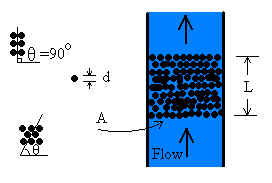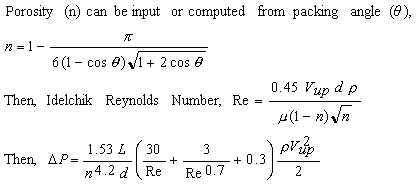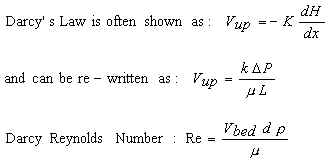
Units: barrel=42 U.S. gallons, cm=centimeter, cP=centipoise, cSt=centistoke, darcy=permeability unit (1.01325x1012 darcy=1 m2), inch H2O=inch water at 60F, inch Hg=inch mercury at 60F, ft=foot, ft fluid=ft of whatever fluid is flowing through the bed, g=gram, gal=U.S. gallon, hr=hour, kg=kilogram, kg/m2-s=kg/s of flow through 1 m2 of upstream area, lb=pound, lb/ft2-s=lb/s of flow through 1 ft2 of upstream area, lb(f)=pound(force), m=meter, m fluid=meters of whatever fluid is flowing through the bed, mbar=millibar, mm=millimeter, mm H2O=mm water at 4C, min=minute, N=Newton, psi=lb/in2, s=second
Introduction
Chemical engineers know this as a packed or porous bed. Groundwater hydrologists
call this a permeameter or flow through porous media. We provide two methods -
Idelchik and Darcy's law - since hydrogeologists and civil engineers are usually more
familiar with Darcy's law while chemical and mechanical engineers may be more familiar
with the Idelchik approach.
The Idelchik method is valid for laminar or turbulent
flow through the bed while Darcy's law is valid only for laminar flow (Darcy Reynolds
Number<10). Another difference is that only Darcy's law requires entering the
permeability. Permeability is used rather than hydraulic conductivity since
permeability is a soil property independent of fluid while hydraulic conductivity is
defined for water only.
If the Idelchik method is selected, permeability will be
back-calculated (based on Darcy's law) in case you want to compare a bed material with a
soil type. We also compute a minor loss coefficient (Km) for flow through
the bed in case the bed is part of a longer pipeline that you are modeling. Any
liquid or gas can be used with either method so long as the fluid's density and viscosity
are known. Several fluids have properties built into the program.
Equations
Idelchik Method (Fried and Idelchik, 1989):
Valid for any porosity and Reynolds number. However, if porosity is
computed from packing angle, the packing angle equation is only valid for packing angles
between 60o and 90o (resulting in computed porosity between 0.2595
and 0.4764).

Darcy's Law Method (e.g. Freeze and Cherry, 1979; Bear, 1979):
Valid for Darcy Reynolds Number < 10 and any porosity. Porosity can
be computed from packing angle from Idelchik's equation above for packing angles between
60o and 90o.

For Both Methods:

For our calculation, all equations were solved analytically for the desired variables,
except when computing velocity and flowrate using the Idelchik method. This required
a numerical solution based on a cubic solver such as presented in Rao (1985).
Variables (Units: F=Force, L=Length,
M=Mass, T=Time)
Aup=Upstream area (column cross-sectional area) [L2].
Abed=Bed area (column cross-sectional area minus area of grains) [L2].
d=Grain diameter [L].
dH/dx=Hydraulic gradient [unit-less]. Change in head with respect to
distance.
k=Permeability of particles [L2].
K=Hydraulic conductivity [L/T]. Not used in calculation but shown in
equations above. Instead of K, k is used in calculations since it is independent of
fluid type.
Km=Minor loss coefficient of bed [unit-less].
L=Bed length [L]. Also known as permeameter length.
M=Mass flow rate [M/T].
n=Porosity of bed. Enter as decimal. For example, enter 35% as 0.35.
Q=Volumetric flow rate [L3/T].
Re(Idelchik)=Reynolds number defined by Idelchik method [unit-less]. Based
on upstream velocity.
Re(Darcy)=Reynolds number for Darcy method [unit-less]. Based on bed
velocity.
Vup=Upstream velocity [L/T]. Also known as Darcy velocity.
Upstream of porous bed.
Vbed=Bed velocity [L/T]. Velocity of fluid flowing through the
bed. Also known as pore velocity.
ρ=Fluid density [M/L3].
μ=Fluid dynamic viscosity [F-T/L2] or [M/L-T].
ΔP=Pressure loss [F/L2]. Upstream Pressure - Downstream Pressure. This computation does not include the pressure change of the water due to elevation difference from inlet to outlet. It is only the pressure loss due to the porous media. It is as if the flow is horizontal.
θ=Packing angle [radians or degrees]. Angle between successive rows of particles.
Soil Properties
Soil properties compiled from Freeze and Cherry
(1979), Bear (1979), Hillel (1982), and Sanders (1998).
| Soil Type | Permeability, k (m2) | Porosity, n | Grain Size, d (mm) |
| Clayey | 10-18 - 10-15 | 0.4 - 0.7 | < 0.002 |
| Silty | 10-16 - 10-12 | 0.35 - 0.5 | 0.002 - 0.05 |
| Sandy | 10-14 - 10-10 | 0.25 - 0.5 | 0.05 - 2 |
| Gravelly | 10-10 - 10-7 | 0.25 - 0.4 | > 2 |
Error Messages
Input checks. If one of these messages appear, the
calculation will not proceed.
Lower limits on variables:
"A must be > 0", "Density must be > 0", "Viscosity must
be > 0", "Grain dia must be > 0", "L must be > 0",
"k must be > 0", "Pressure loss must be > 0", "M must be
> 0", "Q must be > 0", "Vbed must be > 0".
Upper limits on variables:
"A must be < 1e50 m2", "Density must be < 1e6 kg/m3",
"Viscosity must be < 1e9 m2/s", "d must be < 1000 m",
"L must be < 1e10 m", "k must be < 100 m2", "P
loss must be < 1e50 Pa", "M must be < 1e50 kg/s", "Q must be
< 1e50 m3/s", "Vbed must be < 1e50 m/s".
Other limits on variables:
"Porosity out of range". Porosity must be between 0.00001 and
0.99999.
"Angle out of range". If packing angle is entered, it must be
between 60o and 90o.
"L must be ≥ d". Bed length cannot be less than grain size.
Run-time errors. The following messages may be
generated during execution:
"Infeasible input." May occur when using Idelchik method and
solving for flowrate using input values that approach machine precision (e.g. Pressure
loss of 10-200 Pa) and are physically unrealistic.
"L will be < d." May appear if bed length is being computed,
and the length will be less than the grain diameter.
"Darcy Re >10." Will appear only if the Darcy method was
selected, and the Darcy Reynolds number is > 10. Darcy's law is only valid for
laminar flow which is defined as Re(Darcy)<10. This is only a warning message;
results will be computed and shown.
References
Bear, J. 1979. Hydraulics of Groundwater. McGraw-Hill Pub Co.
Freeze, R. A. and J. A. Cherry. 1979. Groundwater. Prentice Hall, Inc.
Fried, E. and I. E. Idelchik. 1989. Flow Resistance: A Design Guide for Engineers. Hemisphere Pub. Corp.
Hillel, D. 1982. Introduction to Soil Physics. Academic Press, Inc.
Rao, S. S. 1985. Optimization Theory and Applications. Wiley Eastern Limited. 2ed.
Sanders, L. L. 1998. A Manual of Field Hydrogeology. Prentice Hall, Inc.
© 2001-2025 LMNO Engineering, Research, and Software, Ltd. All rights reserved.
LMNO Engineering, Research, and Software, Ltd.
7860 Angel Ridge Rd. Athens, Ohio 45701 USA Phone: (740) 707‑2614
LMNO@LMNOeng.com
https://www.LMNOeng.com
